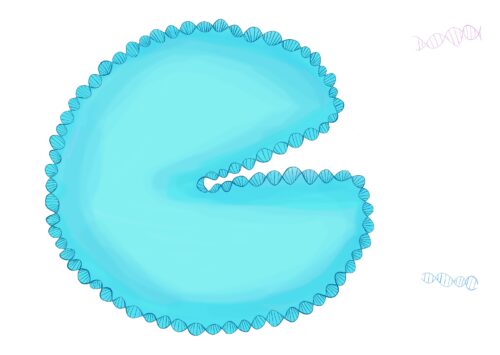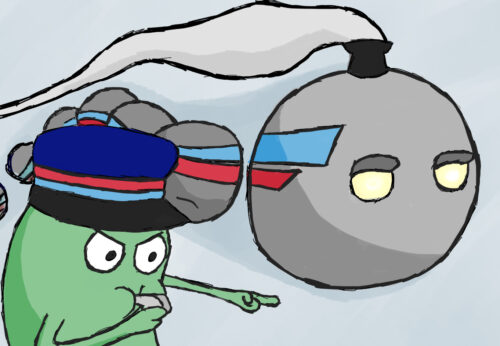Art by Aastha Paudel and Elliot Lichtm
The stomach is both a gatekeeper and a destroyer, designed to reduce everything we consume into its most basic components before permitting passage into the bloodstream. While essential for immune defense, the gatekeeper poses a lethal barrier for protein-based therapeutics. Proteins are fragile by design: uniquely structured, carefully folded, highly reactive, and easily dismantled by acid and enzymes long before they reach their targets. For decades, researchers have tried to outsmart this problem by shielding protein drugs from the gut, layering them with coatings or reformulating them in capsules. But what if the solution isn’t to outwit the stomach’s defenses, but to enlist a courier the body already recognizes and trusts?
Protein therapies, from insulin to monoclonal antibodies, have historically been administered by injection as decades of research failed to make oral delivery more efficient. Through the 1970s and 1980s, pharmaceutical companies explored protective coatings designed to resist stomach acids, only to watch those drugs dissolve too early or remain unabsorbed. The cost, inconsistency, and clinical failures of these trials led to a pivot toward injectables. However, this route is far from ideal. They require trained personnel and often deter patients, especially those with chronic conditions, from consistent use due to pain or anxiety. The idea of a swallowable protein drug, one that could travel safely through the gut and still work systemically, never truly died—it just needed help from a new vehicle.
The stomach is filled with hydrochloric acid and proteases, which are enzymes that chop proteins into amino acids. Even if a therapeutic protein avoids being degraded in the stomach, it enters the small intestine where it faces a gauntlet of bile salts and more enzymes, designed to further digest complex molecules. If the protein remains intact, it then confronts the intestinal barrier: a tightly packed layer of epithelial cells joined by “tight junctions” and coated in mucus, both of which block unwanted substances. For therapeutic proteins, the gut is a hostile, nearly impenetrable environment.
Scientists have attempted to circumvent these hurdles through a variety of strategies. Some have tried wrapping proteins in nanoparticles—tiny synthetic or biological shells designed to protect their contents. Others have developed coatings that resist digestion and only dissolve in the less acidic environment of the small intestine. Some approaches involve co-administering enzyme inhibitors to temporarily disarm the digestive enzymes that would otherwise dismantle the drug. Each of these methods tackles one part of the problem, but none have proven to be a comprehensive fix. Nanoparticles can be difficult to manufacture with consistent quality, and enzyme inhibitors can interfere with normal digestion. What remains is a fundamental need for a system that can protect protein drugs through the gut, help them enter circulation efficiently, and be practical for long-term use. Such a system would also need to be stable, scalable, biocompatible, and efficient.
That’s where the type zero secretion system (T0SS) comes in. Developed by a team of researchers in a study led by first-author Xu Gong and senior author Yun Yang’s team at Beihang University, T0SS repurposes a natural feature of gram-negative bacteria: outer membrane vesicles, or OMVs. These vesicles, which bud off from the bacterial membrane, are normally used by microbes to communicate and interact with their environment.
For this team of researchers, T0SS emerged from a personal motivation. “My husband struggled with gout, having to lie on his side when it flared,” Yang said. “When we looked into available treatments, I found there wasn’t a single safe or effective drug to cure, treat, or even mitigate it. That’s why I decided to develop a new kind of biological drug.”
The breakthrough came when Gong discovered that specifically engineered bacterial vesicles could transport therapeutic proteins into the bloodstream. “The limitation of altering the genetic makeup of bacteria to treat diseases is that all the drugs delivered by probiotic bacteria are limited to the gut area,” Yang said. “We wanted to break this limitation.” The researchers engineered E. coli Nissle 1917, a probiotic strain considered safe by the Food and Drug Administration, to overproduce these OMVs and to fill them with therapeutic proteins. To achieve this, they deleted a gene called nlpI, which suppresses vesicle formation, thereby boosting OMV production nearly threefold. Proteins of interest such as uricase or lactate oxidase—enzymes that help break down uric and lactic acid, respectively—were tagged with signal peptides. These signal peptides are short amino acid sequences that direct the proteins into the area between the bacterium’s inner and outer membranes, where OMVs form.
What makes this discovery more fascinating is its serendipitous nature. “We accidentally discovered that the altered membrane vesicles of the bacteria could enter circulation,” Yang said. “After that discovery, we decided to use this altered membrane vesicle as a delivery platform to deliver uricase into the circulation.”
This approach is striking not only for its creativity, but for its efficiency. In the case of green fluorescent protein, the encapsulation efficiency was 97.9 percent, a rate far superior to what is typically achieved with synthetic loading techniques which use electric fields or sound waves to disrupt membranes. Experiments further demonstrated that OMVs could simultaneously carry multiple distinct protein cargos—enabling, in theory, combination therapies. When delivered orally to mice, the vesicle-encapsulated proteins resisted degradation in simulated gastric and intestinal fluids and were detected in organs like the liver and kidneys hours after administration.
Perhaps most importantly, the encapsulated proteins retained their activity, meaning they were still functional and able to carry out their intended biological tasks. In experiments with hyperuricemic mice, which serve as models for gout and other uric acid-related disorders, OMV-delivered uricase significantly reduced serum uric acid levels—restoring them nearly to normal—while improving kidney function and lowering inflammatory markers. Mice that received uricase through conventional secretion systems or unmodified bacteria showed little to no improvement. The difference lies in stability and delivery range: T0SS enables proteins to survive longer and reach farther.
Beyond animal models, the system showed promise in preliminary human studies. Uricase-loaded OMVs were found to reduce uric acid levels by over forty percent in serum samples from hyperuricemia patients within thirty minutes, with no effect on glucose levels. Likewise, lactate-loaded OMVs lowered lactate in lung cancer serum samples without altering unrelated biomarkers, indicating specificity. These findings underscore the clinical potential of T0SS as a programmable therapeutic platform that could be adapted to carry different drugs for different diseases.
If the system scales successfully, it could transform the treatment landscape for several chronic and metabolic disorders. “Compared to other kinds of drug delivery systems, bacteria can be engineered to sense and respond to signals from the microenvironment,” Yang said.
Diabetes management, long dominated by insulin injections, might one day rely on OMV-encapsulated insulin taken as a capsule. Autoimmune diseases that currently depend on injectable monoclonal antibodies could become more manageable with oral therapies. Enzyme replacement therapies for rare genetic disorders—often burdened by high cost and invasive delivery—might be made more accessible through bacterial vesicle delivery. The implications are enormous, both for global health and for pharmaceutical design.
Still, hurdles remain. One concern is batch-to-batch variability in OMV composition. Yang acknowledges these limitations; the team is now working to improve gut barrier penetration and circulation time. While the engineered bacteria produce vesicles with high encapsulation efficiency, OMVs are biologically heterogeneous by nature. Standardizing doses, ensuring consistent bioavailability, and addressing potential immune responses to repeated exposure are challenges that will need to be addressed before clinical translation. The team is also working on optimizing vesicle purification and scaling production for industrial use.
The foundational insight—using the microbiome as a drug delivery engine—leans into the body’s symbiotic relationship with bacteria rather than relying on synthetic materials. By turning engineered probiotics into therapeutic factories, the researchers have opened a new avenue for oral biologics. Their work suggests that future pills may be living systems that collaborate with our bodies in real time.


